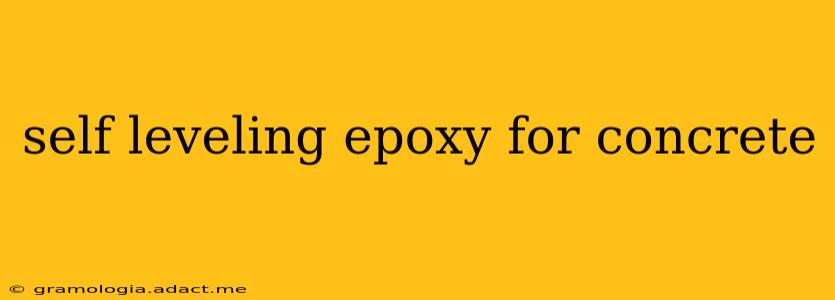Self-leveling epoxy is a powerful solution for creating smooth, durable, and aesthetically pleasing concrete surfaces. Whether you're tackling a DIY project in your garage or overseeing a large-scale commercial application, understanding the nuances of this material is crucial for success. This comprehensive guide will explore everything you need to know about self-leveling epoxy for concrete, from its applications and benefits to preparation and application techniques.
What is Self-Leveling Epoxy for Concrete?
Self-leveling epoxy is a two-part epoxy resin system designed to flow and self-level to create a flawlessly smooth, even surface on concrete floors. Unlike traditional epoxy coatings that require troweling or other leveling techniques, this specialized formula uses its inherent properties to achieve a perfect finish. It's a highly durable and chemically resistant coating ideal for various applications, offering superior protection and a stunning visual appeal.
What are the Benefits of Using Self-Leveling Epoxy?
The advantages of choosing self-leveling epoxy for your concrete surfaces are numerous:
- Exceptional Durability: Self-leveling epoxy creates a highly resistant surface capable of withstanding heavy foot traffic, impacts, and abrasion.
- Chemical Resistance: It provides excellent protection against chemicals, oils, and stains, making it perfect for garages, workshops, and industrial settings.
- Aesthetic Appeal: The smooth, even finish enhances the visual appeal of any concrete floor, creating a modern and sleek look.
- Ease of Application: While proper preparation is key, the self-leveling nature of the epoxy simplifies the application process compared to other concrete coatings.
- Improved Hygiene: The seamless surface prevents the accumulation of dirt, dust, and bacteria, making it ideal for food processing areas, hospitals, and cleanrooms.
What are the Different Types of Self-Leveling Epoxy?
Several types of self-leveling epoxy cater to various needs and budgets:
- Standard Self-Leveling Epoxy: Offers a good balance of durability, chemical resistance, and cost-effectiveness.
- High-Build Self-Leveling Epoxy: Ideal for filling imperfections and creating a thicker, more durable coating.
- UV-Resistant Self-Leveling Epoxy: Designed to withstand prolonged exposure to sunlight, preventing yellowing and degradation.
- Colored Self-Leveling Epoxy: Available in a wide range of colors to personalize your concrete floor.
How to Prepare Concrete for Self-Leveling Epoxy?
Proper preparation is paramount for a successful self-leveling epoxy application. Neglecting this step can compromise the adhesion and longevity of the coating. Key steps include:
- Cleaning: Thoroughly clean the concrete surface to remove all dust, debris, oil, grease, and other contaminants. A pressure washer is often beneficial.
- Repairing: Repair any cracks, holes, or other imperfections in the concrete using appropriate patching compounds.
- Priming: Apply a suitable epoxy primer to enhance adhesion and ensure proper bonding between the epoxy and the concrete substrate. This step is crucial.
- Grinding: Grinding the surface may be necessary to achieve optimal smoothness and remove any laitance (a weak layer of cement paste on the surface).
How is Self-Leveling Epoxy Applied?
The application process generally involves these steps:
- Mixing: Carefully mix the two components of the epoxy according to the manufacturer's instructions.
- Pouring: Pour the mixed epoxy onto the prepared concrete surface, ensuring even distribution.
- Spreading: Use a spiked roller or other approved tool to spread the epoxy evenly and remove any air bubbles. This is crucial for preventing pinholes.
- Curing: Allow the epoxy to cure completely according to the manufacturer's recommendations. This process typically takes several days.
What are the safety precautions for using self-leveling epoxy?
Self-leveling epoxy contains chemicals that can be harmful if not handled correctly. Always wear appropriate personal protective equipment (PPE), including gloves, safety glasses, and a respirator. Work in a well-ventilated area and follow the manufacturer's safety guidelines meticulously.
How long does self-leveling epoxy take to dry?
Drying time depends on several factors including the type of epoxy, temperature, and humidity. However, expect a curing time of several days, and possibly a week or more for full cure and optimal durability. Consult the manufacturer's instructions for the specific product you choose.
How much self-leveling epoxy do I need?
The amount of epoxy required depends on the size of the area to be covered and the desired thickness. Use the manufacturer's recommended coverage rate to calculate the needed quantity.
Can I apply self-leveling epoxy over existing paint or coatings?
Generally, it's not recommended. Existing coatings can interfere with adhesion, leading to failure. Proper preparation by removing existing materials is essential for optimal results.
What are the common mistakes to avoid when applying self-leveling epoxy?
Common mistakes include inadequate surface preparation, improper mixing of the epoxy components, inadequate ventilation, and not following the manufacturer's instructions. Avoid rushing the process and ensure you dedicate sufficient time for each step.
By carefully following these steps and understanding the nuances of self-leveling epoxy, you can achieve a beautiful, durable, and long-lasting concrete floor. Remember to always consult the manufacturer's instructions for your specific product.
